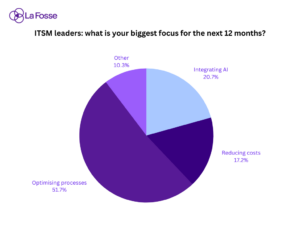The IT service management (ITSM) sector is ideally placed to help shape how businesses operate and deliver value.
From maintaining a robust IT framework to keeping an eye on emerging trends, ITSM leaders are a key driver of innovation and business growth.
But how can ITSM leaders bring value and navigate their many challenges?
During our recent ITSM Summit event, we brought together ITSM leaders to discuss how to get the most from your teams and what the future holds for the industry.
Here’s a round-up of the key themes from the night.
Set up for success
ITSM, like any other service, needs clearly defined goals to measure success.
It may sound obvious, but it’s vital to be clear on the role of ITSM in your business. What does the user want? What do they need? If your service meets or exceeds expectations, you’ll have a seat at the table and get the visibility and influence you need to drive value.
When you’re working on large matrix projects, make people accountable and get cross functional teams to work together. This will ensure projects don’t take too long and cost too much. Fast feedback loops are a useful way to keep teams engaged. Collate feedback, produce improvement plans and showcase delivery.
The tools you use are also a key factor in user perception. ServiceNow is used by nearly 85% of Fortune 500 companies and 70% of our ITSM Summit attendees, but it may not be the best fit for you. Gartner’s magic quadrant can help you understand where you stand.
Move from traditional to agile
There’s a growing expectation for ITSM to be flexible and adaptable to business needs. Essentially, you shouldn’t work for the processes, the processes should work for you.
Cloud transformation has made it easier for ITSM teams to work to within an agile framework, and make the most of the flexible roadmaps, ongoing adjustments and constant collaboration that comes with it.
It’s also allowed for a closer relationship between ITSM and DevOps. While the teams may have a different focus, they can come together to deliver shared objectives. Integrating tools and systems between the teams is a useful way to share knowledge and align on strategic projects.
While agile brings many benefits it’s important to not lose sight of traditional ITSM principles. Strong processes and detailed documentation complement agile ideals and make for a strong structure that delivers a better user experience, reduced risk, improved culture and better adherence to regulations.
Optimise with automation
Automation and AI will undoubtedly have a part to play in the future of ITSM. However, its implementation should be linked to business objectives. If automation doesn’t help you achieve your goals, it’s not much more than a vanity project.
Depending on your use case, automation can bring about significant benefits. For example, it can allow you to simplify processes to allow service desk agents to focus on continual service improvement (CSI). Virtual assistants, chatbots and machine learning can all help optimise your process, cut costs and improved user experience.
In a poll of ITSM leaders after our event, over 50% said that optimising processes and productivity were their focus points for the next 12 months, with integrating AI the next most popular goal.

This highlights that process is still a key focus for ITSM leaders and AI and automation is likely to be part of that journey. But it’s important to stress that a human element and a personal touch will always be needed.
Build great teams
Alongside having a clear strategy and access to relevant tooling, building a strong team culture team is key. The book Radical Candor by Kim Scott outlines how leaders can be more effective by combining sincerity with care.
Modern ITSM should move away from a command-and-control culture to one that promotes collaboration and problem solving. An example being the simple switch from ‘change manager’ to ‘change enabler’ mindset. This will help ITSM SMEs to think like a developer, becoming more agile and able to adapt to challenges, and foster an environment for continuous improvements.
The change in team culture can also be seen at leadership level. A recent trend has showed a shift from a traditional CIO approach to the people- and product-led CDO vision.
But team culture is only as effective as talent you have available. Hiring staff that can successfully manage change and are comfortable working with a range of stakeholders will remain a core part of delivering value.
Get in touch with ITSM recruitment experts
At La Fosse, we help leaders build great teams. We have built strong relationships with a large network of ITSM professionals over 10 years, making us well placed to find the match for any of your future hiring.
If you have an immediate hiring need, or would like to discuss the ITSM market, please submit a brief.
